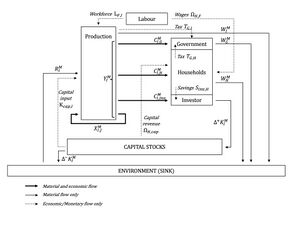MATCGE
General Scope and Connection with Climate Mitigation
Introduction
We introduce a CGE model that endogenously includes physical flows subject to material balance constraints. We propose a new framework that more accurately describes the interaction between transaction values and material flows and thereby becomes particularly relevant for the ex-ante analysis of CE policies and autonomous developments.
The model structure is very generic and has the following structure: firms producing goods , factors of production , and households and institutions . We have the following variables: for output by firms (which equals sales and total production costs), where we may omit the subscript for convenience as we do not use the symbol for other agents. for intermediates from firms to firms , using the symbol equivalently (alias) to . is factor use by firms, and is supply by consumers. is consumption by households, respectively. is taxes on resource use or waste generation.
Model Scope
Our model is generic and includes only one geographical region for now. It includes intermediary deliveries, consumption (government and households), labour and investment. It can be used iteratively, and a dynamically integrated version is under development.
The main specificity of our model is that material flows are endogenously adjusted. Underlying material flows are indexed and are linked to economic flows through material intensities : , .
Material input is a natural resource in production: . Waste comes from consumption, capital depreciation and a share of material in production.
Note that it is possible to include as many materials as needed.
Model Development
- Status: The CGE model with endogenous material flows has a robust generic theoretical basis and the code to illustrate it. Further developments include adding stock vintages, more precise Circular Economy elements, and quality differentiation.
- Environment: python.
- Documentation: available for the current version of the model.
- Source code: available for the static and iterative model. The time-integrated version is still under development.
Circular Economy Features
This section provide the CE features of the model
R Words coverage and implemented in the model
- Refuse (R0): adding an exogenous constraint on a sectorial output (economic or material flow);
- R2b Business model shift (Reduce (R2)): including a service sector;
- R2e Lifetime extension (Reduce (R2)): introducing capital and stock vintages, the lifetime can be extended by modifying capital depreciation rate or expected lifespans;
- R2f Lightweighting (Reduce (R2)): The model endogenously adjusts material intensity (kg/euro), which can also be interpreted as quality (in euro/kg)
- R2g Material substitution (Reduce (R2)): The model allows for several layers of material flows (i.e. for one Social Accounting Matrix - SAM - we can add several Physical Input-Output Tables - PIOT), and materials substitute endogenously.
- R2h+i Less fabrication scrap (Reduce (R2)): The ratio of industrial waste per material input can be adjusted. The mechanism of R2g can also be included.
- R3-7 Reuse (Re-use (R3), Repair (R4), Refurbish (R5), Remanufacture (R6), Repurpose (R7)): This can be included with the addition of a detailed waste sector that allows for households to trade their own goods.
- R8 Recycle (Recycle (R8)): including a recycling sector with either direct recycling from the flow of waste or recycling from "waste mining" (with a waste stock).
- Recover (R9): including a disaggregated waste sector that includes energy recovery.
CE strategies and connection with climate change mitigation.
Among all PIOT that can be added to the model, a GHG one can be included.
Insights for Analytical Framework
We provided a theoretical framework for the integration of industrial ecology considerations in macroeconomic analysis, as well as a simple general equilibrium framework to understand the role of endogenous material flow accounting when computing an equilibrium. In particular, we introduce material balances in a CGE by tracking material flows in each sector, from extraction to waste management. We complement the standard SAM, used for CGE analysis, with PIOTs for each material tracked in the model. Both accounting matrices are linked through material intensity variables, the inverse of which can be interpreted as the quality of the material flow. When we include carbon in the material tracking, we can address climate change jointly with other material flows. The approach fundamentally enables us to track physical flows in the economy at disaggregated levels. It allows for policy analysis of material unit taxation both upstream and downstream.
The model addresses a common criticism by environmental researchers that macroeconomics lacks physical consistency. We show how CGEs can describe strict material balances and policies directed to material constraints on inflows/outflows, taxation of materials (in euros per kg) as well as its exhaustive monitoring in all economic sectors. The development of the model is a first step for a deeper understanding of the effect of the development of a CE at a macro level. Indeed, this analysis requires precise material accounting to measure CE opportunities and their underlying economic and climate impacts.
Refinement, Integration, Future Development
The following sections are optional and should be completed only if relevant.
Refinement process
- Use of empirical data on aggregate economic and physical flows
- CES tree production in the Python code (the theoretical framework already holds for generic production functions)
Integration
This stylized model is the base of the framework used in Workpackage 5, Task 5.2.
Future features of the model
- More precise representation of CE features (for instance, stock vintages, hedonic representation of the quality of goods)



















